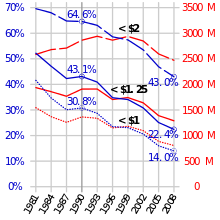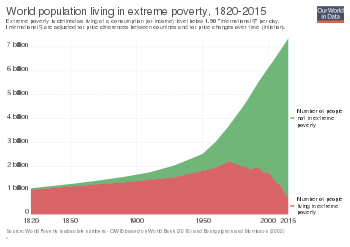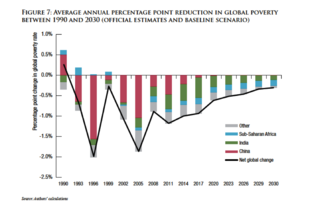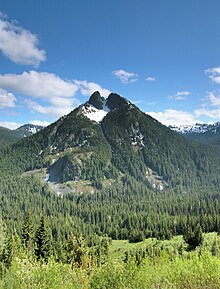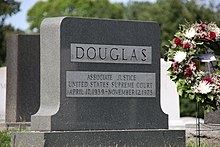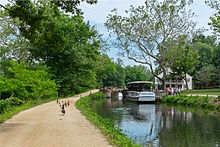Graph
of global population living on under 1, 1.25 and 2 equivalent of 2005
US dollars daily (red) and as a proportion of world population (blue)
based on 1981–2008 World Bank data
The poverty threshold, poverty limit or poverty line is the minimum level of income deemed adequate in a particular country. In practice, like the definition of poverty, the official or common understanding of the poverty line is significantly higher in developed countries than in developing countries. In 2008, the World Bank came out with a figure (revised largely due to inflation) of $1.25 a day at 2005 purchasing-power parity (PPP). In October 2015, the World Bank updated the international poverty line
to $1.90 a day. The new figure of $1.90 is based on ICP purchasing
power parity (PPP) calculations and represents the international
equivalent of what $1.90 could buy in the US in 2011. The new IPL
replaces the $1.25 per day figure, which used 2005 data. Most scholars agree that it better reflects today's reality, particularly new price levels in developing countries. The common international poverty line has in the past been roughly $1 a day.
At present the percentage of the global population living under extreme
poverty is likely to fall below 10% according to the World Bank
projections released in 2015, although this figure is claimed by
scholars to be artificially low due to the effective reduction of the
IPL in 2015.
Determining the poverty line is usually done by finding the total
cost of all the essential resources that an average human adult
consumes in one year. The largest of these expenses is typically the rent
required to live in an apartment, so historically, economists have paid
particular attention to the real estate market and housing prices as a
strong poverty line affector. Individual factors are often used to
account for various circumstances, such as whether one is a parent,
elderly, a child, married, etc. The poverty threshold may be adjusted
annually.
History
Charles Booth, a pioneering investigator of poverty in London at the turn of the 20th century, popularised the idea of a poverty line, a concept originally conceived by the London School Board.
Booth set the line at 10 (50p) to 20 shillings (£1) per week, which he
considered to be the minimum amount necessary for a family of four or
five people to subsist on. Benjamin Seebohm Rowntree (1871–1954), a British sociological researcher, social reformer and industrialist, surveyed rich families in York,
and drew a poverty line in terms of a minimum weekly sum of money
"necessary to enable families … to secure the necessaries of a healthy
life", which included fuel and light, rent, food, clothing, and
household and personal items. Based on data from leading nutritionists of the period, he calculated the cheapest price for the minimum calorific
intake and nutritional balance necessary, before people get ill or lose
weight. He considered this amount to set his poverty line and concluded
that 27.84% of the total population of York lived below this poverty
line.
This result corresponded with that from Charles Booth's study of
poverty in London and so challenged the view, commonly held at the time,
that abject poverty was a problem particular to London and was not
widespread in the rest of Britain. Rowntree distinguished between primary poverty, those lacking in income and secondary poverty, those who had enough income, but spent it elsewhere (1901:295–96).
Absolute poverty
The term "absolute poverty" is also sometimes used as a synonym for extreme poverty. Absolute poverty is the absence of enough resources to secure basic life necessities.
According to a UN declaration that resulted from the World Summit on Social Development
in Copenhagen in 1995, absolute poverty is "a condition characterised
by severe deprivation of basic human needs, including food, safe
drinking water, sanitation facilities, health, shelter, education, and
information. It depends not only on income, but also on access to
services."
David Gordon's paper, "Indicators of Poverty and Hunger", for the
United Nations, further defines absolute poverty as the absence of any
two of the following eight basic needs:
- Food: Body mass index must be above 16.
- Safe drinking water: Water must not come solely from rivers and ponds, and must be available nearby (fewer than 15 minutes' walk each way).
- Sanitation facilities: Toilets or latrines must be accessible in or near the home.
- Health: Treatment must be received for serious illnesses and pregnancy.
- Shelter: Homes must have fewer than four people living in each room. Floors must not be made of soil, mud, or clay.
- Education: Everyone must attend school or otherwise learn to read.
- Information: Everyone must have access to newspapers, radios, televisions, computers, or telephones at home.
- Access to services: This item is undefined by Gordon, but normally is used to indicate the complete panoply of education, health, legal, social, and financial (credit) services.
Basic needs
The basic needs approach is one of the major approaches to the measurement of absolute poverty in developing countries. It attempts to define the absolute minimum resources necessary for long-term physical well-being, usually in terms of consumption goods. The poverty line is then defined as the amount of income
required to satisfy those needs. The 'basic needs' approach was
introduced by the International Labour Organization's World Employment
Conference in 1976.
"Perhaps the high point of the WEP was the World Employment Conference
of 1976, which proposed the satisfaction of basic human needs as the
overiding objective of national and international development policy.
The basic needs approach to development was endorsed by governments and
workers' and employers' organizations from all over the world. It
influenced the programmes and policies of major multilateral and
bilateral development agencies, and was the precursor to the human
development approach."
A traditional list of immediate "basic needs" is food (including water), shelter, and clothing.
Many modern lists emphasize the minimum level of consumption of 'basic
needs' of not just food, water, and shelter, but also sanitation,
education, and health care. Different agencies use different lists.
In 1978, Ghai investigated the literature that criticized the
basic needs approach. Critics argued that the basic needs approach
lacked scientific rigour; it was consumption-oriented and antigrowth.
Some considered it to be "a recipe for perpetuating economic
backwardness" and for giving the impression "that poverty elimination is
all too easy". Amartya Sen focused on 'capabilities' rather than consumption.
In the development discourse, the basic needs model focuses on the measurement of what is believed to be an eradicable level of poverty.
Relative poverty
Relative poverty means low income relative to others in a country;
for example, below 60% of the median income of people in that country.
It is the "most useful measure for ascertaining poverty rates in wealthy
developed nations". Relative poverty measure is used by the United Nations Development Program (UNDP), the United Nations Children's Fund (UNICEF), the Organisation for Economic Co-operation and Development (OECD) and Canadian poverty researchers.[18][19][20][21][22]
In the European Union, the "relative poverty measure is the most
prominent and most–quoted of the EU social inclusion indicators."
"Relative poverty reflects better the cost of social inclusion and equality of opportunity in a specific time and space."
"Once economic development has progressed beyond a certain
minimum level, the rub of the poverty problem – from the point of view
of both the poor individual and of the societies in which they live – is
not so much the effects of poverty in any absolute form but the effects
of the contrast, daily perceived, between the lives of the poor and the
lives of those around them. For practical purposes, the problem of
poverty in the industrialized nations today is a problem of relative
poverty (page 9)."
However, some have argued that as relative poverty is merely a
measure of inequality, using the term 'poverty' for it is misleading.
For example, if everyone in a country's income doubled, it would not
reduce the amount of 'relative poverty' at all.
History of the concept of relative poverty
In 1776, Adam Smith
argued that poverty is the inability to afford "not only the
commodities which are indispensably necessary for the support of life,
but whatever the custom of the country renders it indecent for
creditable people, even of the lowest order, to be without."
In 1958, John Kenneth Galbraith
argued, "People are poverty stricken when their income, even if
adequate for survival, falls markedly behind that of their community."
In 1964, in a joint committee economic President's report in the
United States, Republicans endorsed the concept of relative poverty: "No
objective definition of poverty exists. ... The definition varies from
place to place and time to time. In America as our standard of living
rises, so does our idea of what is substandard."
In 1965, Rose Friedman
argued for the use of relative poverty claiming that the definition of
poverty changes with general living standards. Those labelled as poor in
1995, would have had "a higher standard of living than many labelled
not poor" in 1965.
In 1979, British sociologist, Peter Townsend
published his famous definition: "individuals... can be said to be in
poverty when they lack the resources to obtain the types of diet,
participate in the activities and have the living conditions and
amenities which are customary, or are at least widely encouraged or
approved, in the societies to which they belong (page 31)."
Brian Nolan and Christopher T. Whelan of the Economic and Social Research Institute (ESRI) in Ireland explained that "poverty has to be seen in terms of the standard of living of the society in question."
Relative poverty measures are used as official poverty rates by
the European Union, UNICEF and the OEDC. The main poverty line used in
the OECD and the European Union is based on "economic distance", a level of income set at 60% of the median household income.
Relative poverty compared with other standards
A measure of relative poverty
defines "poverty" as being below some relative poverty threshold. For
example, the statement that "those individuals who are employed and
whose household equivalised disposable income is below 60% of national
median equivalised income are poor" uses a relative measure to define
poverty.
The term relative poverty can also be used in a different sense to mean "moderate poverty" – for example, a standard of living or level of income that is high enough to satisfy basic needs (like water, food, clothing, housing, and basic health care), but still significantly lower than that of the majority of the population under consideration.
National poverty lines
2008
CIA World Factbook-based map showing the percentage of population by
country living below that country's official poverty line
National estimates are based on population-weighted subgroup
estimates from household surveys. Definitions of the poverty line do
vary considerably among nations. For example, rich nations generally
employ more generous standards of poverty than poor nations. Even among
rich nations, the standards differ greatly. Thus, the numbers are not
comparable among countries. Even when nations do use the same method,
some issues may remain.
In United States, the poverty thresholds are updated every year
by Census Bureau. The threshold in United States are updated and used
for statistical purposes. In 2015, in the United States, the poverty
threshold for a single person under 65 was an annual income of
US$11,770; the threshold for a family group of four, including two
children, was US$24,250. According to the U.S. Census Bureau data released on 13 September 2011, the nation's poverty rate rose to 15.1 percent in 2010.
In the UK, "more than five million people – over a fifth (23
percent) of all employees – were paid less than £6.67 an hour in April
2006. This value is based on a low pay rate of 60 percent of full-time
median earnings, equivalent to a little over £12,000 a year for a
35-hour working week. In April 2006, a 35-hour week would have earned
someone £9,191 a year – before tax or National Insurance".
India's official poverty level as of 2005, on the other hand, is
split according to rural versus urban thresholds. For urban dwellers,
the poverty line is defined as living on less than 538.60 rupees
(approximately US$12) per month, whereas for rural dwellers, it is
defined as living on less than 356.35 rupees per month (approximately
US$7.50).
Wealth inequality
Poverty is impacted through wealth inequality, while the rich are getting richer the poor are losing even more.
Wealth facilitates the continuation of economic inequality, the lowest
quintile of Americans only own less than 1 percent of all wealth in
America while the top quintile owns 60 percent of the wealth.
Wealth inequality is more extreme and a larger indicator of financial
well being than income inequality, this means it impacts people in
poverty even more.
People in poverty do not have the access to resources that in the upper
quintile do, such as stocks, investments, multiple houses, stable jobs,
and better education.
Stocks are a good example of this, while 94.9 of the top 1 percent own
stocks only 20.8 percent of the bottom 20 percent of Americans own
stock. This inequality of access allows for wealth inequality to grow and continue to impact those in poverty.
Women and children
Women
and children find themselves impacted by poverty more often than men,
most specifically when apart of single mother families. This is due to the feminization of poverty, how the poverty rate of women has increasingly exceeded that of mens.
While the overall poverty rate is 12.3%, women are 13.8% likely to fall
into poverty and men are below the overall rate at 11.1%.
Most women if they fall into poverty because of the expectation that
they will be taking care of children while trying to maintain their
jobs, because of the expectation that women will be with kids they are
segregated into lower paying jobs than male counterparts. Along with being put into lower paying jobs women do more unpaid work for their children than men do. This is how the percent of single mothers has risen to 34%, much above the national rate.
Women and children (as single mother families) find themselves as apart
of low class communities because they are 21.6% more likely to fall
into poverty.
Racial minorities
Racial
minorities have been a large part of American history. A minority group
is defined as “a category of people who experience relative
disadvantage as compared to members of a dominant social group.”
Minorities are traditionally separated into the following groups:
African Americans, American Indians, Alaska Natives, Asians, Pacific
Islanders, and Hispanics.
They must be accounted for when discussing the poverty line in the U.S.
in 2018 because the majority of America's population consists of
immigrants.
According to the current U.S. Poverty statistics, Black Americans -
21%, Foreign born non-citizens - 19%, Hispanic Americans - 18%, and
Adults with a disability - 25%.
This does not include all minority groups, but these groups alone
account for 85% of people under the poverty line in the United States. Whites have a poverty rate of 8.7%; the poverty rate is more than double for Black and Hispanic Americans.
Impacts on education
Living below the poverty threshold can have a major impact on a child’s education. The psychological stresses induced by poverty may affect a student’s ability to perform well academically. In addition, the risk of poor health is more prevalent for those living in poverty. Health issues commonly affect the extent to which one can continue and fully take advantage of his or her education. Poor students in the United States are more likely to dropout of school at some point in their education. Research has also found that children living in poverty perform poorly academically and have lower cognitive abilities. Impoverished children also display more behavioral issues than others.
Schools in impoverished communities usually do not receive much
funding, which can also set their students apart from those living in
more affluent neighborhoods.
Even upward mobility that brings a child out of poverty may not have a
significant positive impact on his or her education; inadequate academic
habits that form as early as preschool typically do not improve despite
changes in socioeconomic status.
Impacts on healthcare
The nation’s poverty threshold is issued by the Census Bureau.
According to the Office of Assistant Secretary for Planning and
Evaluation the threshold is statistically relevant and can be a solid
predictor of people in poverty.
The reasoning for using Federal Poverty Level, FPL, is due to its
action for distributive purposes under the direction of Health and Human
Services. So FPL is a tool derived from the threshold but can be used
to show eligibility for certain federal programs.
Federal poverty levels have direct effects on individual’s healthcare.
In the past years and into the present government, the use of the
poverty threshold has consequences for such programs like Medicaid and
the Children’s Health Insurance Program.
The benefits which different families are eligible for are contingent
on FPL. The FPL, in turn is calculated based on federal numbers from the
previous year.
The benefits and qualifications for federal programs are dependent on
number of people on a plan and the income of the total group.
For 2019, the U.S Department of health & Human Services enumerate
what the line is for different families. For a single person, the line
is $12,490 and up to $43,430 for a family of 8, in the lower 48 states.
Another issue is reduced-cost coverage. These reductions are based on
income relative to FPL, and work in connection with public health
services such as Medicaid. The divisions of FPL percentages are nominally, above 400%, below 138% and below 100% of the FPL. After the advent of the American Care Act, Medicaid was expanded on states bases. For example, enrolling in the ACA kept the benefits of Medicaid when the income was up to 138% of the FPL.
Poverty mobility and healthcare
Health
Affairs along with analysis by Georgetown found that public assistance
does counteract poverty threats between 2010 and 2015. In regards to Medicaid, child poverty is decreased by 5.3%, and Hispanic and Black poverty by 6.1% and 4.9% respectively. The reduction of family poverty also has the highest decrease with Medicaid over other public assistance programs.
Expanding state Medicaid decreased the amount individuals paid by an
average of $42, while it increased the costs to $326 for people not in
expanded states. The same study analyzed showed 2.6 million people were
kept out of poverty by the effects of Medicaid.
From a 2013-2015 study, expansion states showed a smaller gap in health
insurance between households making below $25,000 and above $75,000.
Expansion also significantly reduced the gap of having a primary care
physician between impoverished and higher income individuals. In terms of education level and employment, health insurance differences were also reduced. Non-expansion also showed poor residents went from a 22% chance of being uninsured to 66% from 2013 to 2015.
Poverty dynamics
Living above or below the poverty threshold is not necessarily a position in which an individual remains static.
As many as one in three impoverished people were not poor at birth;
rather, they descended into poverty over the course of their life.
Additionally, a study which analyzed data from the Panel Study of
Income Dynamics (PSID) found that nearly 40% of 20-year-olds received
food stamps at some point before they turned 65.
This indicates that many Americans will dip below the poverty line
sometime during adulthood, but will not necessarily remain there for the
rest of their life.
Furthermore, 44% of individuals who are given transfer benefits (other
than Social Security) in one year do not receive them the next.
Over 90% of Americans who receive transfers from the government stop
receiving them within 10 years, indicating that the population living
below the poverty threshold is in flux and does not remain constant.
Criticisms
Using a poverty threshold is problematic because having an income
slightly above or below is not substantially different; the negative
effects of poverty tend to be continuous rather than discrete, and the
same low income affects different people in different ways. To overcome
this problem, a poverty index or indices can be used instead; see income inequality metrics.
A poverty threshold relies on a quantitative,
or purely numbers-based, measure of income. If other human
development-indicators like health and education are used, they must be
quantified, which is not a simple (if even achievable) task.
Using a single monetary poverty threshold is problematic when
applied worldwide, due to the difficulty of comparing prices between
countries. Prices of the same goods vary dramatically from country to
country; while this is typically corrected for by using purchasing power parity
(PPP) exchange rates, the basket of goods used to determine such rates
is usually unrepresentative of the poor, most of whose expenditure is on
basic foodstuffs rather than the relatively luxurious items (washing
machines, air travel, healthcare) often included in PPP baskets. The
economist Robert C. Allen
has attempted to solve this by using standardized baskets of goods
typical of those bought by the poor across countries and historical
time, for example including a fixed calorific quantity of the cheapest
local grain (such as corn, rice, or oats).
Understating poverty
In addition to wage and salary income, investment income and government transfers such as SNAP
(Supplemental Nutrition Assistance Program, also known as food stamps)
and housing subsidies are included in a household's income. Studies
measuring the differences between income before and after taxes and
government transfers, have found that without social support programs,
poverty would be roughly 30% to 40% higher than the official poverty
line indicates.
Further, the U.S. Census Bureau calculates the poverty line the
same throughout the U.S. regardless of the cost-of-living in a state or
urban area. For instance, the cost-of-living in California, the most
populous state, was 42% greater than the U.S. average in 2010, while the
cost-of-living in Texas, the second-most populous state, was 10% less
than the U.S. average.
In 2017, California had the highest poverty rate in the country when
housing costs are factored in, a measure calculated by the Census Bureau
known as "the supplemental poverty measure".
